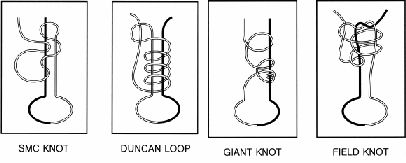Arthroscopic sliding knot: How many additional half-hitches are really needed?
Authors: Seung-Ho Kim, Jae Chul Yoo, Joon Ho Wang, Kui Won Choi, Tae Soo Bae, Chang Yang Lee
References: Arthroscopy 2005 Apr;21(4):405-11.
Abstract
Purpose: To evaluate the optimal number of additional half-hitches needed to achieve optimal knot-holding capacity (KHC) of lockable sliding knots. Type of study: Mechanical testing study. Methods: Four configurations of arthroscopic knots (Duncan loop, Field knot, Giant knot, and SMC knot) were tested for their knot-holding capacity. For each knot configuration, 6 sequential knots were made including the initial sliding knot and an additional 5 knots by increasing the half-hitches 1 at a time. Each additional half-hitch was made as a reverse half-hitch with alternate posts. For each sequential knot configuration, 12 knots were made using No. 2 braided sutures. On the Servo-hydraulic materials testing system (Instron 8511; MTS, Minneapolis, MN), cyclic loading, load to clinical failure (3-mm displacement), load to ultimate failure, and mode of failure were measured. Results: Most of the initial loops without additional half-hitches showed dynamic failure with cyclic loading. However, after 1 additional half-hitch, all 3 (SMC, Field, and Giant) knots showed resistance to dynamic cyclic load. After 2 additional half-hitches, the Duncan loop was secured without slippage from the cyclic loading test. The mean displacement after the end of cyclic loading decreased with each additional half-hitch. In particular, the SMC and Giant knot reached plateau at 0.1-mm or less displacement after 1 additional half-hitch. The Field knot and Duncan loop needed 3 additional half-hitches. The SMC knot and Duncan loop needed 1 additional half-hitch to reach greater than 80 N at clinical failure, whereas the other 2 knots needed 2 additional half-hitches. For the load exceeding 100 N for clinical failure, the SMC knot required 3 additional half-hitches and the other 3 knots needed 4 additional half-hitches. Addition of more than 3 half-hitches did not increase the load to clinical failure in the SMC knot. However, load to clinical failure increased up to 4 additional half-hitches in the other 3 knots (P < .05). The load to ultimate failure reached plateau when 3 or more additional half-hitches were made for all knot configurations. As the number of additional half-hitches increased, the mode of failure switched from pure loop failure (slippage) to material failure (breakage). The Duncan loop showed poor loop security—even with 5 additional half-hitches, some failed by slippage (17%). On the other hand, after 3 additional half-hitches, the 3 other knots showed greater than 75% of failure by material breakage mode (SMC and Field 92%, Giant 75%). Conclusions: Even with its own locking mechanism, a lockable sliding knot alone does not withstand the initial dynamic cyclic load. For all tested variables, the SMC knot required a minimum of 2 additional half-hitches. All knots showed a near plateau in knot security with 3 or more additional half-hitches. The Duncan loop may need more than 3 additional half-hitches for optimal security.
Clinical relevance: The study shows that the knots tested needed at least 2 additional half-hitches, so this should become standard clinical practice.
Displacement after the end of dynamic cyclic load for each knot on each added RHAP.




